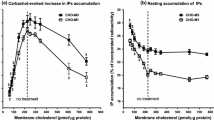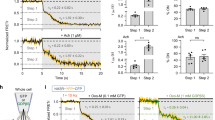Abstract
In the present studies, the pharmacology and regulation of the functional muscarinic receptors on HSDM1C1 cells were probed using phosphoinositide (PI) turnover assays. In addition, the receptor binding of the putative M3-selective radioligand, [3H]4-DAMP, to cell homogenates was characterized. Carbachol (EC50=9 μM), (+)muscarine (EC50=4.5 μM) and cis-dioxolane (EC5=0.72 μM) were full agonists which stimulated PI turnover by 13.3±1.0 fold above basal values. The potencies of numerous agonists in this assay system were relatively similar to their affinities in receptor binding assays. Exposure of HSDM1C1 cells to 10 nM–10 μM muscarine during the last 24h of [3H]myo-inositol-labeling resulted in a concentration-dependent reduction in the cisdioxolane affinity and maximal PI response induced by subsequent treatment with cis-dioxolane. pertussis toxin (5–2000 ng/ml) caused a partial reduction in the cis-dioxolane-induced PI turnover. Likewise, exposure of the HSDM1C1 cells to an active phorbol ester (TPA) resulted in a partial inhibition of the cis-dioxolane-induced (100 μM) PI turnover. The half-maximal effect of TPA was produced at 1.8±0.3 nM. [3H]4-DAMP binding to cell homogenates was of high affinity (Kd=0.19±0.04 nM) and moderate capacity (Bmax=201±22 fmol/mg protein). The pharmacological specificity (4-DAMP>p-FHHSiD>dicyclomine>pirenzepine>methoctramine>AFDX-116 >gallamine) resembled that for [3H]NMS binding and correlated well with that observed for inhibition of PI turnover. These studies further support the identification of M3 receptors on HSDM1C1 cells. These receptors have been shown to be influenced by pertussis toxin, an active phorbol ester and to exhibit desensitization.
Similar content being viewed by others

References
Nathanson, N. M. 1987. Molecular properties of the muscarinic acetylcholine receptor. Ann. Rev. Neurosci. 10:195–236.
Bonner, T., Buckley, N. J., Young, A. C., and Brann, M. R. 1987. Identification of a family of muscarinic acetylcholine receptor genes. Science 237:527–532.
Hulme, E. C., Birdsall, N. J. M., and Buckley, N. J. 1990. Muscarinic receptor subtypes. Annu. Rev. Pharmacol. Toxicol. 30: 633–673.
Berridge, M. J., and Irvine, R. F. 1984. Inositol trisphosphate, a novel second messenger in cellular signal transduction. Nature 312:315–321.
Richards, M. H. 1991. Pharmacology and second messenger interactions of cloned muscarinic receptors. Biochem. Pharmacol. 42:1645–1650.
Ransom, J. T., Cherwinski, R. E., Delmendo, R. E., Sharif, N. A., and Eglen, R. M. 1991. Characterization of the m4 muscarinic receptor Ca2+-response in a subclone of PC-12 cells by single cell flow cytometry. J. Biol. Chem. 266:11738–11745.
Sharif, N. A., and Whiting, R. L. 1990. Stimulation of inositol phosphate production in clonal HSDM1C1 cells by endothelins and sarafotoxin. Biochem. Pharmacol. 40:1929–1931.
Sharif, N. A., and Whiting, R. L. 1993. The neuropeptide bradykinin stimulates phosphoinositide turnover in HSDM1C1 cells: B2-antagonist-sensitive responses and receptor binding studies. Neurochem. Res. 18:1313–1320.
Eglen, R. M., Sharif, N. A., and To, Z. P. 1993. Muscarinic M3 receptors mediate total inositol phosphates accumulation in murine HSDM1C1 fibrosarcoma cells. Eur. J. Pharmacol. (Mol. Pharm. Section) 244:49–55.
Arunlakshan, O., and Schild, H. O. 1959. Some quantitative uses of drug antagonists. Brit. J. Pharmacol. 14:48–58.
Orellana, S. A., Solski, P. A., and Brown, J. H. 1985. Phorbol ester inhibits phosphoinositide hydrolysis and calcium mobilization in cultured astrocytoma cells. J. Biol. Chem. 260:5236–5240.
Delmendo, R. E., Michel, A. D., and Whiting, R. L. 1989. Affinity of muscarinic antagonists for three putative muscarinic receptor binding sites. Brit. J. Pharmacol. 96:457–464.
Michel, A. D., Delmendo, R. E., Stefanich, E., and Whiting, R. L. 1989. Binding characteristics of the muscarinic subtype of the NG108-15 cell line. Naunyn Schmiedeberg's Arch. Pharmacol. 340:62–67.
Michel, A. D., Stefanich, E., and Whiting, R. L. 1989. Direct labeling of rat M3 muscarinic receptors by [3H]4-DAMP. Eur. J. Pharmacol. 166:459–466.
Munson, P. J., and Rodbard, D. 1980. LIGAND: A versatile computerized approach for the characterization of ligand binding systems. Anal. Biochem. 107:220–239.
Becherer, P.R., Mertz, L. F., and Baenziger, N. L. 1982. Regulation of prostaglandin synthesis mediated by thrombin and B2 bradykinin receptors in a fibrosarcoma cell line. Cell 30:243–251.
Fisher, S. K., and Heacock, A. M. 1988. A putative M3 muscarinic cholinergic receptor of high molecular weight couples to phosphoinositide hydrolysis in human SK-N-SH neuroblastoma cells. J. Neurochem. 50:984–987.
Kunysz, E. L., Michel, A. D., Whiting, R. L., and Woods, K. 1989. The human astrocytoma cell line 1321N1 contains M2-glandular type muscarinic receptors linked to phosphoinositide tumover. Brit. J. Pharmacol. 96:271–278.
Kunysz, E. A., Michel, A. D., and Whiting, R. L. 1988. Functional and direct binding studies using subtype selective muscarinic receptor antagonists. Brit. J. Pharmacol. 93:491–500.
Eglen, R. M., Michel, A. D., Montgomery, W. W., Kunysz, E. A., Machado, C. A., and Whiting, R. L. 1990. The interaction of paraflourohexahydrosialadifenidol at muscarinic receptors in vitro. Brit. J. Pharmacol. 99:637–642.
Doods, M. N., Mathy, M. J., Davidesko, D., Van Charldorp, K. J., De Jonge, A., and Van Zweiten, P. A. 1987. Selectivity of muscarinic antagonists in radioligand and in vivo experiments for the putative M1, M2 and M3 receptors. J. Pharmacol. Expt. Ther. 242:257–262.
Lamberecht, G., Feifel, R., Forth, B., Stohmann, C., Tack, R. and Mutschler, E. 1988. p-Fluoro-hexahydro-sila-difenidol: the first M2β-selective muscarinic antagonist. Eur. J. Pharmacol. 152:193–194.
Ford, A. P. D. W., Levine, W. B., Baxter, G. S., Harris, G., Eglen, R. M., and Whiting, R. L. 1991. Pharmacological, biochemical and molecular characterization of muscarinic receptors in the guinea pig ileum: a multidisciplinary approach. Mol. Neuropharmacol. 1:117–121.
Hammer, R., Berrie, C. P., Birdsall, N. J. M., Burgen, A. S. V., and Hulme, E. C. 1980. Pirenzepine distinguishes between subclasses of muscarinic receptors. Nature 283:90–92.
Michel, A. D., and Whiting, R. L. 1988. Methoctramine, a polymethylene tetramine, differentiates three subtypes of muscarinic receptor in direct binding studies. Eur. J. Pharmacol. 145:61–66.
Lazareno, S., Kendall, D. A., and Nahorski, S. R. 1985. Pirenzepine indicates heterogeneity of muscarinic receptors linked to cerebral inositol phospholipid metabolism. Neuropharmacol. 24:593–595.
Kopp, R., Lambrecht, G., Mutschler, E., Moser, U., Tacke, R., and Pfeifer, A. 1989. Human HT-29 colon carcinoma cells contain muscarinic M3 receptors coupled to phosphoinositide metabolism. Eur. J. Pharmacol. 172:397–405.
Akiyamma, K., Vickery, T. W., Watson, M., Roeske, W. R., Reisine, T. D., Smith, T. L., and Yamamura, H. I. 1986. Muscarinic cholinergic ligand binding to intact mouse pituitary tumor cells (AtT-20/D16-16) coupling to two biochemical effectors: adenylate cyclase and phosphatidylinositol turnover. J. Pharmacol. Expt. Ther. 236:653–661.
Mei, L., Lai, J., Roeske, W. R., Fraser, C. M., Venter, J. C., and Yamamura, H. I. 1989. Pharmacological characterization of the M1 muscarinic receptors expressed in murine fibroblast B82 cells. J. Pharmacol. Expt. Ther. 248:661–669.
Whiting, R. L., Ford, A. P. D. W., Baxter, G. S., Harris, G. S. Sharif, N. A., and Eglen, R. M. 1991. Pharmacological and biochemical analysis of muscarinic receptors in guinea pig ileum in vitro. Brit. J. Pharmacol. 102:19p.
Serra, M., Mei, L., Roeske, W. R., Watson, M., and Yamamura, H. I. 1988. The intact neuroblastoma cell (SH-SY5Y) exhibits high affinity [3H]pirenzepine binding associated with hydrolysis of phosphatidylinositols. J. Neurochem. 50:1513–1521.
Ui, M. 1984. Islet-activating protein, pertussis toxin- a probe for functions of inhibitory nucleotide regulatory component of adenylate cyclase. Trends Pharmacol. Sci. 5:277–279.
Nishizuka, Y. 1984. The role of protein kinase C in cell-surface receptor signal transduction and tumor production. Nature 308:693–698.
Nishizuka, Y. 1988. The molecular heterogeneity of protein kinase C and its implication for cellular regulation. Nature 334:661–665.
Author information
Authors and Affiliations
Rights and permissions
About this article
Cite this article
Sharif, N.A., To, Z.P., Wong, K.H. et al. M3 muscarinic receptors on murine HSDM1C1 cells: Further functional, regulatory, and receptor binding studies. Neurochem Res 20, 61–68 (1995). https://doi.org/10.1007/BF00995154
Accepted:
Issue Date:
DOI: https://doi.org/10.1007/BF00995154



